Editor’s Note: This blog post is part of an ongoing series of posts dedicated to K-12 education policy in Mississippi.
***

By Grace Breazeale I K-12 Policy Associate
Mississippi’s high school graduation rate has steadily risen over the past five years, which would typically be a cause for celebration. But in this case, the rise in graduation rate could be partly due to pandemic-era testing policies, rather than increasing student achievement. In response to the pandemic, the state waived certain graduation requirements for high school students enrolled in state-tested courses during the 2019-2020 or 2020-2021 school years. Thus, schools were able to confer a high school diploma on students who would not have otherwise been able to graduate.
As the state’s high school graduation rate has increased, the proportion of students enrolling in postsecondary institutions after high school has simultaneously declined. Together, the opposing trends of a rising high school graduation rate and falling postsecondary enrollment rate raise questions about the meaning of a high school diploma and the responsibility of high schools in preparing students for their postgraduate lives.
High School Graduation Pathways and Impact of COVID
Minimum requirements to obtain a diploma are necessary; if there were no requirements, anyone could get a diploma and it would not indicate any achievement. In Mississippi, the Department of Education (MDE) establishes high school graduation requirements. In normal years, students must earn 24 Carnegie credits and pass state tests in four core subjects (Algebra I, Biology I, US History, and English II) in order to graduate. Students who fail any of their state tests the first time can sit for a retake. Any students who fail a test on both takes can meet alternative requirements to be eligible for graduation.
When the pandemic emerged as a threat in the spring of 2020 and most instruction moved online, MDE canceled state testing for all students, regardless of grade level. High school students who were enrolled in any of the four state-tested courses were exempt from having to pass state tests for these courses. The following year, MDE allowed similar test exemptions, as many schools continued to offer virtual instruction.
The high school graduation rate consistently rose during these years and the year that followed, which was—at least in part—likely a result of the temporary loosening of graduation requirements. Test requirements that, in the past, would have prevented some students from graduating were no longer a concern for these pandemic-era students.
High School Graduation Rate By Year
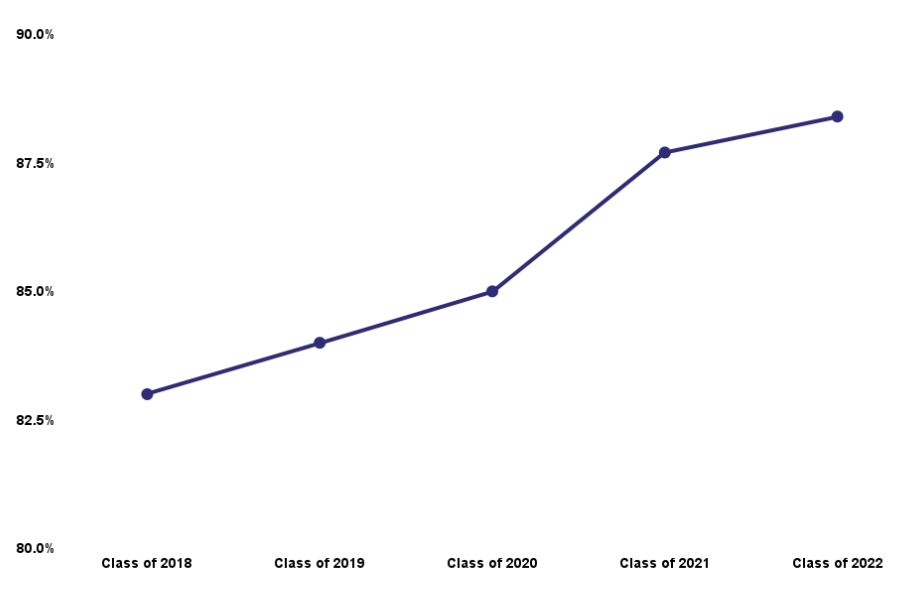
The graphs below show how trends in graduation rates have varied by student subgroup.
High School Graduation Rates by Demographic Group
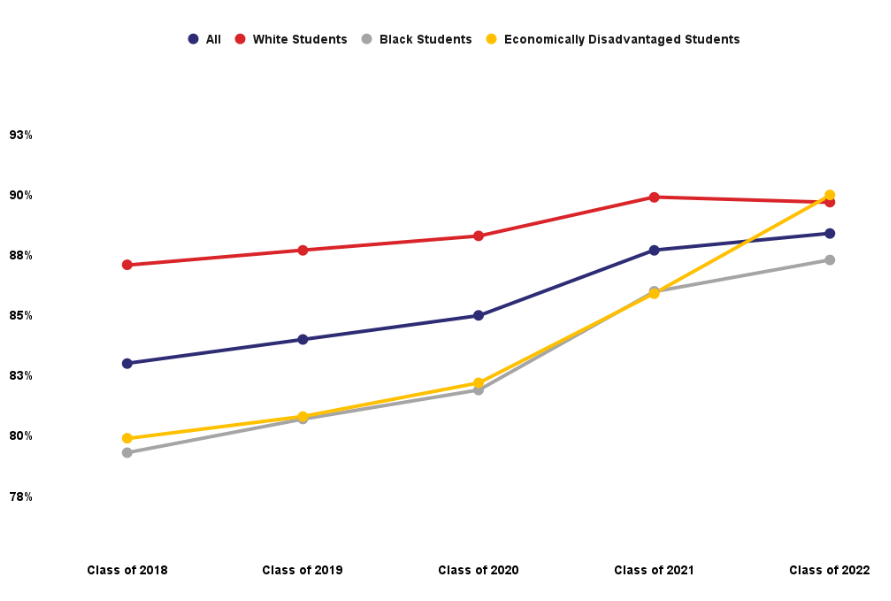
High School Graduation Rate for
Students with Disabilities
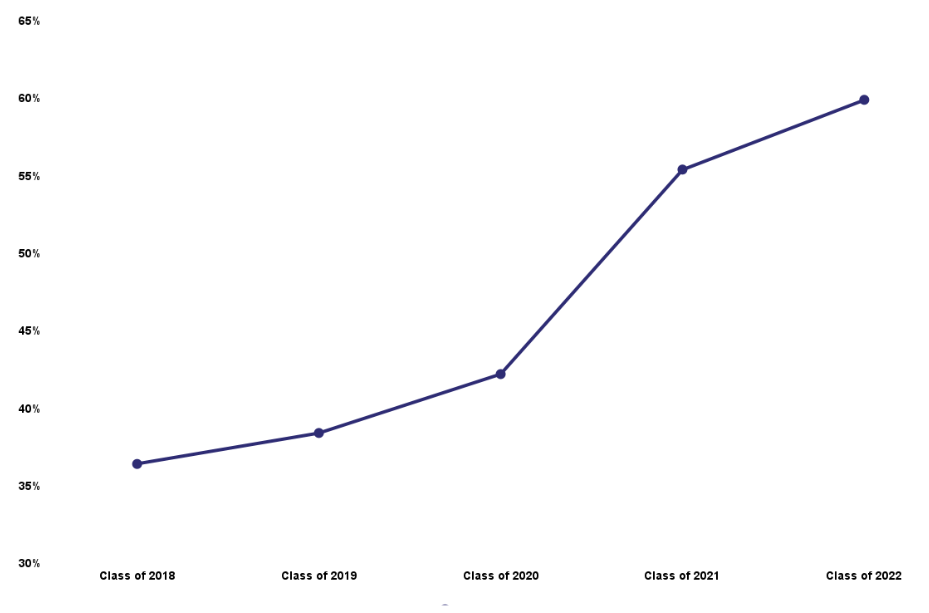
These trends demonstrate how historically-underserved groups—Black students, students with disabilities, and economically disadvantaged students—saw the greatest increases in graduation rates during this time period, indicating that these groups may have benefitted the most from graduation requirement exemptions, and thus, may be most likely to struggle with re-imposed testing requirements.
Implications of the Rising Graduation Rate
On its face, a rising high school graduation rate appears to be positive news for students and for the state. Research has shown that high school graduates have better financial and health outcomes than students who have dropped out of high school. Consequently, high school graduates tend to contribute more tax dollars and be less likely to rely on social welfare programs.
Given the pandemic exemptions, we should be cautious about interpreting the rising graduation rate in the same way as we would have before COVID-19: these students were subject to fewer requirements, so earning a diploma may have a different meaning than it would in pre-pandemic years. While there are obvious benefits to possessing a high school diploma, including being able to apply for jobs that require a high school degree, or choosing to attend a postsecondary institution at any point in the future, some research has shown that having a diploma may mean little if it does not come with a certain level of knowledge and skills. Given the unique context of the past several years, we will likely have to wait to see the full picture of how having a diploma impacted pandemic-era students who otherwise would not have graduated.
Postsecondary enrollment rates can provide a useful starting point in examining these students’ post-high school outcomes.
Trends in Post-Graduation Plans
Though the state’s high school graduation rate has increased, the proportion of students enrolling in postsecondary institutions right after high school remains below its pre-pandemic rate. The graph below demonstrates how this rate has varied over the past several years.
Postsecondary Enrollment Rate By Year
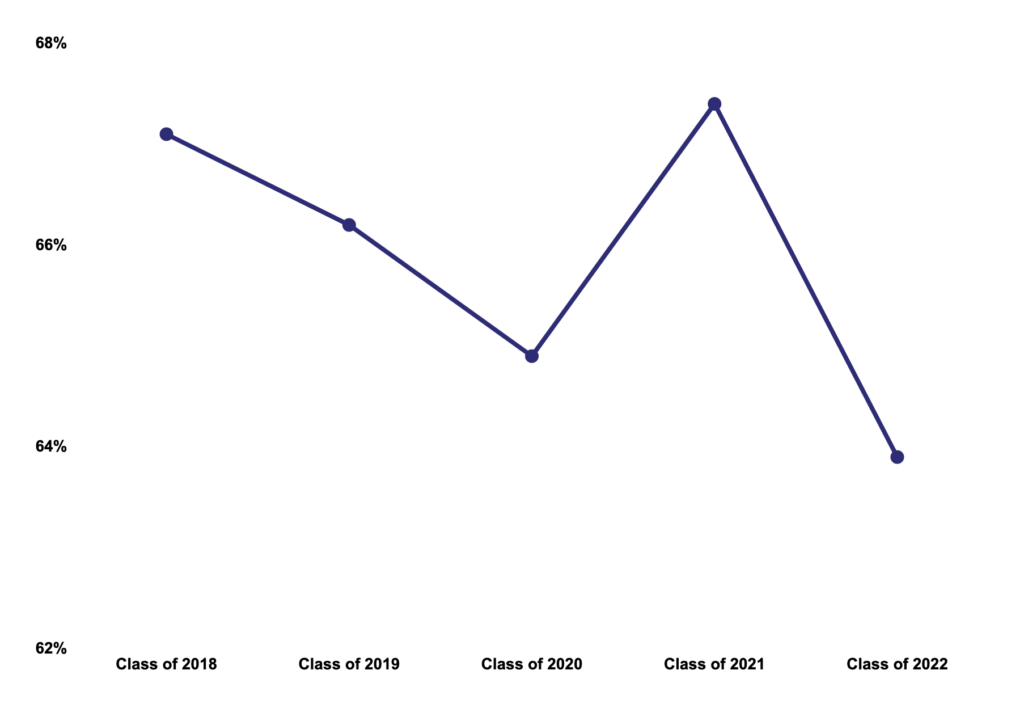
Examining these numbers by subgroup provides a more nuanced view of how students fared in this area. While White students in the Class of 2021 demonstrated a sharp bump in postsecondary enrollment, students in historically underserved groups—economically disadvantaged students, Black students, and students with disabilities—did not similarly enroll in postsecondary institutions at increased rates. Rather, enrollment rates for these groups have shown a consistent decline since the pandemic began. As a result, enrollment rates for White students are higher than they were before the pandemic, but rates are lower for the other three subgroups.
Postsecondary Enrollment Rate By Demographic Group
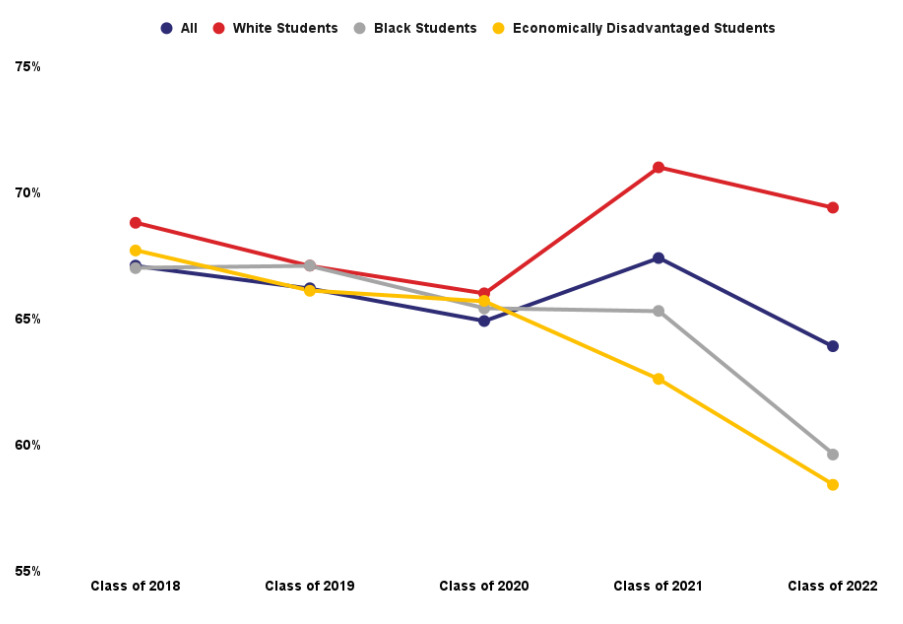
Postsecondary Enrollment Rate for
Students with Disabilities
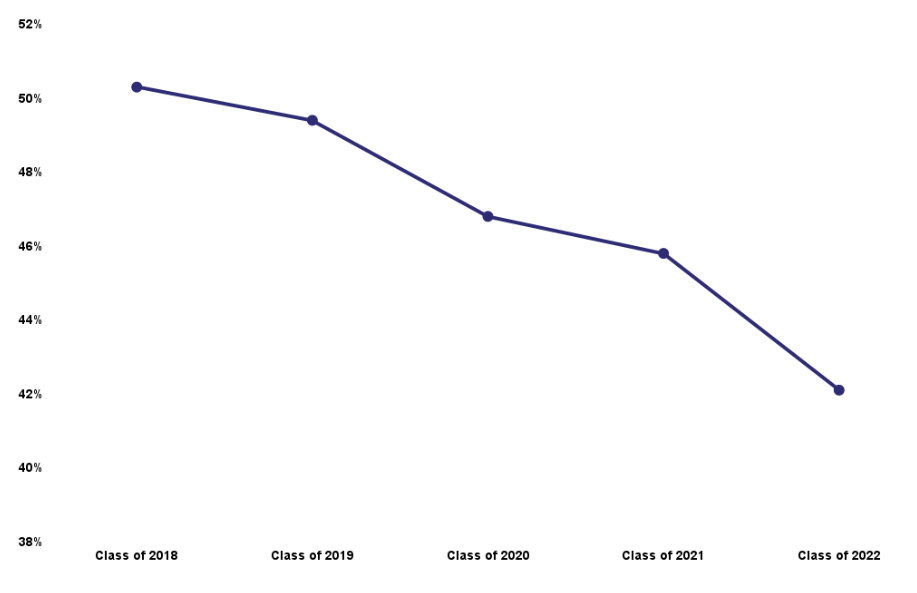
We do not have postsecondary enrollment data for students without disabilities or students from non-economically disadvantaged backgrounds, so we cannot provide direct comparisons across these characteristics, but we can compare the outcomes of students from different racial backgrounds. While there was a relatively narrow gap in postsecondary enrollment rates between White and Black students up until the 2019-2020 school year, the rates began to diverge dramatically in the years that followed. The gap between these groups increased from about 0.2 percentage points to 10 percentage points between 2019 and 2022, as the postsecondary enrollment of Black students experienced a sharp decline. The disparities may not end there: studies on postsecondary institutions around the country have shown that Black students who do enroll in postsecondary institutions have lower completion rates than White students who enroll. As a result, the disparity in postsecondary attainment rate between Black and White students could be even greater than the disparity in the enrollment rate.
What factors have driven these recent trends in postsecondary enrollment? Research on similar trends across the country has indicated that an unusually strong labor market coupled with the increasing cost of college may be contributing to skepticism about the value of a degree among young people. In terms of the increasing disparity between White and Black students, Black students generally take on more student debt and see lower returns on a postsecondary degree than their White peers. These financial drawbacks could magnify their skepticism about the value of a degree.
Concerns Around Postsecondary Enrollment Disparities
In 2020, the Mississippi Education Achievement Council observed that 45% of the working population had a college degree and established a goal of raising this rate to at least 55% by 2030, with a rationale that the future economy will likely require a more educated workforce given the rate of technological advancement. The decreasing rate of postsecondary enrollment could complicate these efforts.
Particularly concerning is the widening gap between the percentage of Black and White students who enroll in a postsecondary institution following high school. Students have the right to choose what they want to do after high school, but when they do not feel like certain options are available or feasible for them, the decision to not pursue a college degree seems less like a choice. This gap is troubling considering the differing economic outcomes of people with and without a college degree.
Takeaways for Schools
We want to emphasize that it is unproductive to take a one-size-fits-all approach to students’ postsecondary pathways. Certain pathways may be best for some students, while different pathways will be best for other students. Individuals should be able to choose the decision that makes the most sense for their situation. However, in order to make an informed decision, students need to know about all of their post-graduation options and be exposed to the advantages and disadvantages of these options. They should not feel like they are predestined for a certain pathway.
To that end, K-12 schools, postsecondary institutions, and state policymakers should take note of several strategies that could be helpful in ensuring students are positioned to succeed upon their graduation from high school.
Urgency of Action
The pandemic did not leave any students unaffected. But, as other measures have shown, students in historically underserved groups appear to have suffered the most acute consequences. The graduation rates for students in these groups may indicate that high school students made it out of the pandemic relatively unscathed, but digging deeper into their postsecondary outcomes tells a different story. Rather than glossing over this information, it is vital that schools approach this data head on and take steps to help reverse the trends in postsecondary enrollment, particularly for the groups that have seen the largest declines.
1 Seniors in the Class of 2020 who had not passed their state tests in prior years also received this exemption. The rationale was that COVID interfered with their ability to retake tests in these courses.
2 Most students take their state-tested exams during their freshman, sophomore, or junior years. Thus, the impact of waived courses became most apparent in 2021, which was the graduation year of students who were juniors during the first year of test exemptions.


What is your recommendation for students who cannot pass the required state test for graduation? Do you suggest them to drop out? When all avenues do not work for said student.
My son is severely dyslexic and cannot pass the state test for graduation. I would love to know if there is another option for him to graduate with his peers. Considering he has had an IEP since 1st grade.
Hi Ms. Jones,
Thank you for your comment – I sent you an email with some resources on this topic.